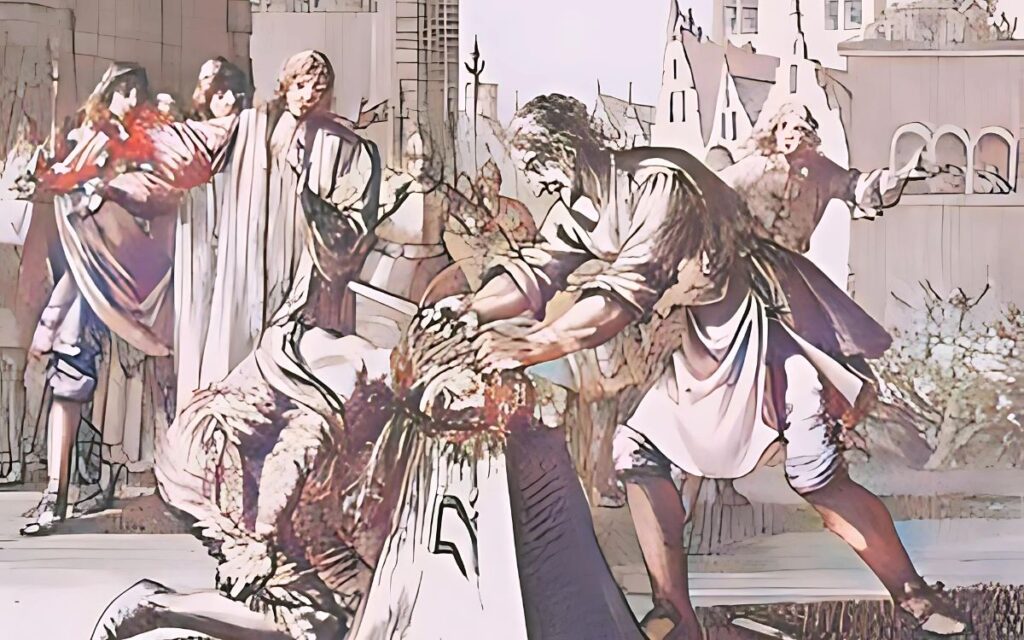Jack Ketch, England’s most notorious executioner, is infamous for both his brutality and incompetence, which turned public executions into horrifying spectacles, writes RICHARD CLEMENTS

Jack Ketch is a name that echoes through history, synonymous with brutality, botched executions, and the shadowy figure of the executioner.
Although his real identity remains partly obscure, Jack Ketch’s 17th-century career as one of England’s most infamous public executioners left a lasting mark on the collective memory of Britain.
His name, long after his death, became not just synonymous with executioners but even death and Satan himself.
Who was this man, and how did he come to embody the darkest role in society?
This article explores Jack Ketch’s life, his macabre job, and how his bungled executions cemented his reputation in the annals of history.
Early Life and Career Beginnings
Little is known about the early life of John Ketch, often referred to as Jack Ketch.
Some sources suggest he may have been of Irish descent, and it’s clear he lived near Gray’s Inn Road in London.
His path to becoming an executioner is somewhat mysterious, though it is believed that he replaced the previous executioner, Edward Dun, around 1663.
Whether Ketch apprenticed under Dun or was appointed after Dun’s death or dismissal remains unclear, as historical records on this transition are sparse.
What is certain is that Ketch soon took on the role of London’s chief executioner under King Charles II, during a period of political turmoil and public spectacle.
Public executions in 17th-century England were not just about dispensing justice but served as theatrical events meant to entertain and, most importantly, instil fear and obedience in the populace.
Jack Ketch quickly became part of this spectacle. He was responsible for carrying out death sentences at Tyburn, one of the most infamous execution sites in London, where criminals and traitors met their end.
The Dark Reputation of Jack Ketch
What set Ketch apart from other executioners of his time was his infamy for botching executions, particularly beheadings.
Execution by hanging was common, but beheading was reserved for high-born individuals, a supposedly swifter and more ‘dignified’ death.
However, Ketch’s lack of skill with the axe turned what should have been quick executions into drawn-out scenes of horror.
One of the most notable of these bungled executions was that of William Russell, Lord Russell, in 1683.
Lord Russell had been convicted of treason for his involvement in the Rye House Plot against King Charles II.
On 21 July 1683, Ketch’s task was to behead the aristocrat swiftly.
What followed, however, was a spectacle of shocking incompetence. Ketch required multiple blows to sever Russell’s head, with some reports claiming he took three or more strikes, the first of which missed entirely and hit Russell’s shoulder.
The crowd was outraged by the barbarity, and Ketch’s reputation as a brutal and incompetent executioner was sealed.
Despite the backlash, Ketch defended his actions. He went so far as to publish a pamphlet titled “The Apologie of John Ketch, Esquire”, in which he claimed that Lord Russell had not “disposed himself suitably”, suggesting that Russell’s posture distracted him.
This excuse did little to salvage his reputation, as the public remained furious over the display.
The Infamous Execution of the Duke of Monmouth
If Lord Russell’s execution was a disaster, the execution of James Scott, the Duke of Monmouth, in 1685, was an even greater catastrophe.
Monmouth, an illegitimate son of Charles II, had led a rebellion against the newly crowned King James II in an attempt to claim the throne.
After the rebellion failed, Monmouth was captured and sentenced to death for treason.
On 15 July 1685, Monmouth faced the executioner’s block, but before laying his head down, he pleaded with Ketch to avoid a repeat of Lord Russell’s ordeal.
He famously said, “Do not hack me as you did my Lord Russell. I have heard that you struck him three or four times.”
Monmouth even gave Ketch six guineas to ensure a swift death.
Despite this, the execution turned into a scene of horror. Ketch delivered five blows with the axe, none of which fully severed Monmouth’s head.
Some reports suggest there were as many as eight strikes.
Ketch eventually had to use a knife to cut the remaining sinews of Monmouth’s neck.
The crowd, already on edge from witnessing such brutality, was incensed. Ketch had to be escorted from the scaffold under military protection to prevent the mob from attacking him.
Ketch’s Other Duties and Greed
Ketch’s incompetence was not limited to beheadings.
As London’s executioner, he was also responsible for hangings, quarterings, and other brutal punishments of the time.
Public hangings were often slow, painful deaths by strangulation, and Ketch, known for his greed, would often accept bribes to hasten the death of his victims.
There were even rumours that he deliberately botched executions for those who did not bribe him sufficiently or were paid more by their enemies to prolong their suffering.
Beyond his duties as an executioner, Ketch made a substantial profit from selling the belongings of the condemned.
It was customary for executioners to take the clothes of the dead, which they would then sell.
Executioners also sold pieces of the hangman’s rope, which were thought to have magical properties.
Superstitions surrounding execution paraphernalia were widespread, with the rope believed to cure ailments or bring good luck.
Ketch, ever opportunistic, exploited these beliefs to supplement his income.
The End of a Notorious Career
Jack Ketch’s life of brutality and greed came to an end in 1686. After a brief imprisonment for “affronting” a sheriff, Ketch’s job was briefly taken over by his assistant, Paskah Rose.
However, Rose’s career was even shorter; he was convicted of robbery and hanged by none other than Ketch himself. Ketch was reinstated but died later that year, leaving behind a legacy that would haunt the role of executioner for generations.
Ketch’s name did not die with him. For centuries, “Jack Ketch” remained a slang term for executioners and, more broadly, for death or the devil.
His reputation as an incompetent and cruel figure, fuelled by pamphlets, ballads, and stories, became part of the folklore surrounding executioners.
In the 19th century, Ketch was immortalised in literature, appearing as a character in puppet shows like Punch and Judy, where he was often tricked by Mr Punch.
His legacy even influenced language, with phrases like “Jack Ketch’s kitchen” referring to the grim workrooms where executioners boiled the severed limbs of traitors.
Jack Ketch may have died more than 300 years ago, but his legacy remains a dark reminder of the brutal spectacle that public executions once were.
His name, synonymous with cruelty, incompetence, and death, continues to echo through history.
While his life as an executioner was marked by greed, brutality, and gruesome botched executions, it is the sheer horror of his incompetence that has kept his story alive for centuries.
Jack Ketch serves as a chilling symbol of a time when public executions were entertainment, and the line between justice and cruelty was thin, indeed.
What did you think of this article about Jack Ketch? Share your thoughts in the comments section!







